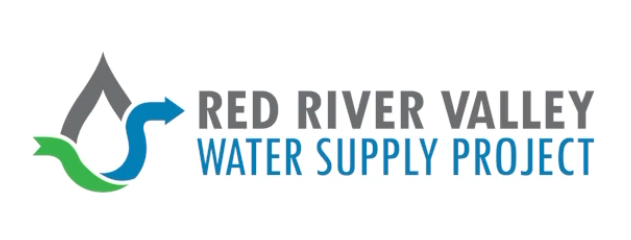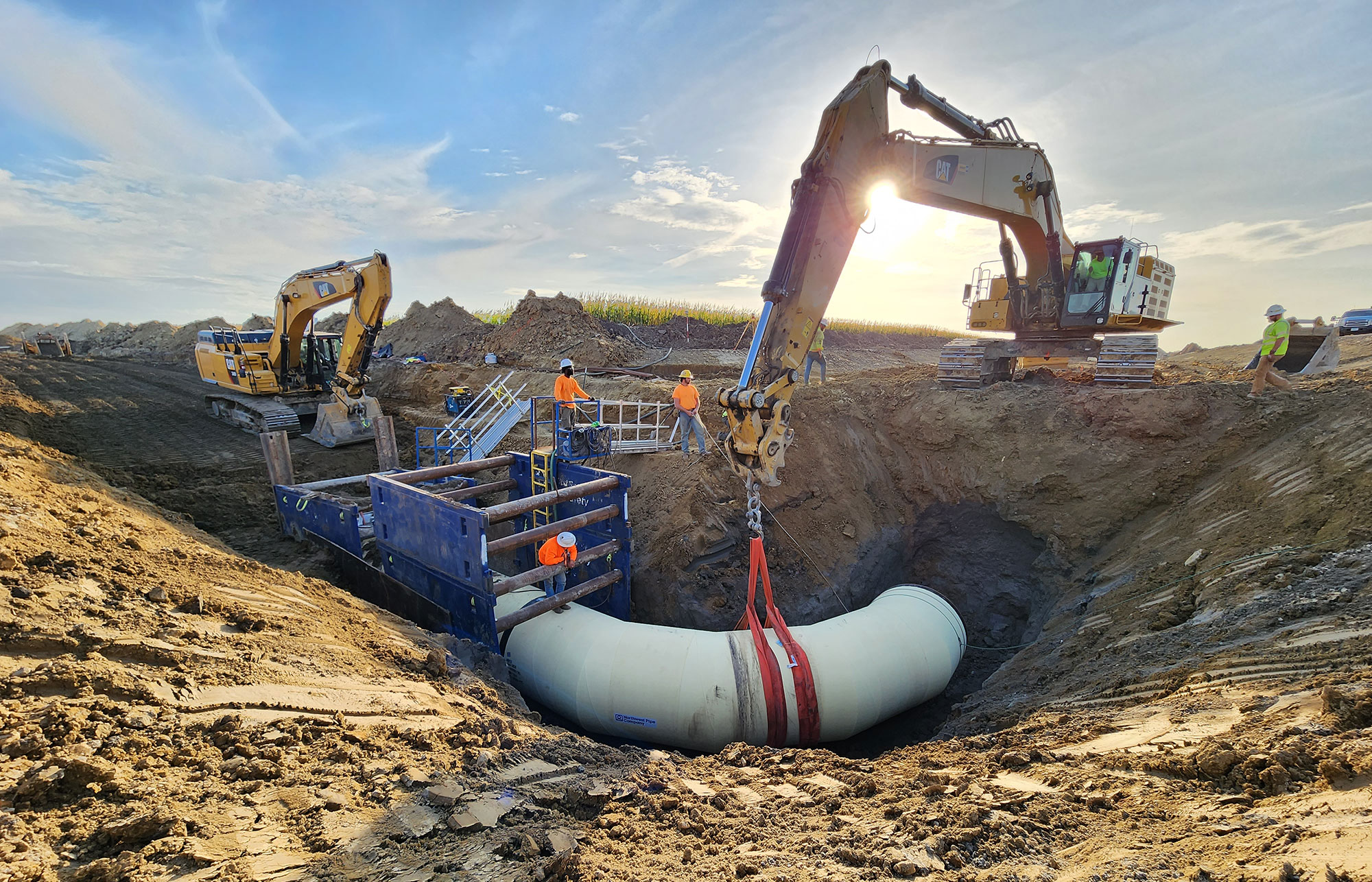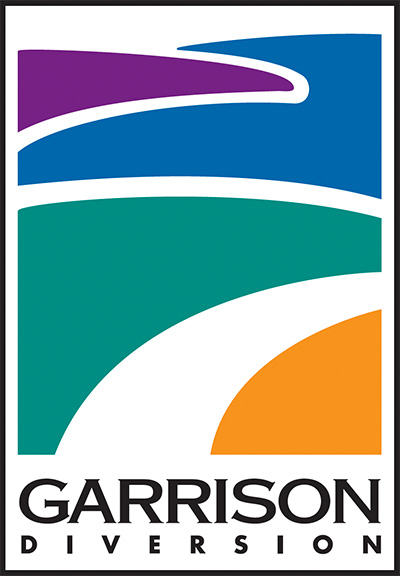Red River Valley Water Supply Project
Water for North Dakota
Central and eastern North Dakota are in need of a reliable, high quality water supply. Without a supplemental water supply during times of water scarcity, there would not be enough water to meet the needs of water users in central North Dakota and the Red River Valley. For this reason, Garrison Diversion and the Lake Agassiz Water Authority are moving forward with the Red River Valley Water Supply Project (RRVWSP).

The project will use a buried pipeline to convey treated Missouri River water from the McClusky Canal in central North Dakota, along Highway 200 to the Sheyenne River to be used by water systems in the central and eastern North Dakota.

The RRVWSP is necessary to protect our communities and economy from the devastating effects of drought. The estimated financial impact of a drought similar to the one North Dakota experienced in the 1930s is $33 billion over a 10-year period. Surface water supplies in central North Dakota and the Red River Valley are limited and unreliable, particularly under drought conditions. Additionally, limited groundwater supplies are nearly fully appropriated. In addition, State law discourages the conversion of groundwater irrigation to drinking water. The supplemental RRVWSP to central and eastern North Dakota during times of water scarcity will protect public health, ensure ongoing economic vitality, and provide for environmental benefits in the river systems.
State and Local Project
The original Red River Valley Water Supply Project was conceived as a federal, state and local project. Without federal authorization in place, local leaders and stakeholders began to look for a state and local option to complete the much needed project.
To learn more about the Red River Valley Water Supply Project, please visit the project website at www.rrvwsp.com.
Federal Project History
Authorized by the Dakota Water Resources Act
The Dakota Water Resources Act (DWRA) of 2000 authorized the RRVWSP in order to provide a reliable supply of quality drinking water for the Red River Valley. The need for the project arose from the drought-prone Red River. Studies show a severe drought, similar to that of the 1930s, will likely repeat by the year 2050. If this were the case, water supplies in the Red River Valley would be insufficient. For this reason, the RRVWSP was proposed. The DWRA also mandated the preparation of an Environmental Impact Statement (EIS) with joint leadership between the federal government and the State of North Dakota. Garrison Diversion was designated by the governor to represent the State of North Dakota in the RRVWSP.
View the Red River Valley Memorandum of Understanding between the Bureau of Reclamation and the Garrison Diversion Conservancy District.
Environmental Impact Statement
Garrison Diversion (representing the State of North Dakota) and the Bureau of Reclamation (representing the federal government) were co-leads in the development of the EIS.
The purpose of the EIS was to evaluate alternatives to meet the long-term water needs of the Red River Valley in North Dakota and three border cities in Minnesota; East Grand Forks, Moorhead and Breckenridge.
Several steps were taken before the Final EIS was developed. First, a Draft EIS was released in December 2005, evaluating eight alternatives to meet the water supply needs of the Red River Valley. In January 2007, the Supplemental Draft EIS was released, containing revisions to the Draft EIS. The Supplemental Draft EIS was written to incorporate responses to comments received on the Draft EIS. Additional analyses relevant to environmental concerns and issues were conducted in response to the comments.
After the additional analysis, the Supplemental Draft EIS eliminated two of the alternatives contained in the Draft EIS from further consideration and identified the GDU Import to the Sheyenne River as the state- and federally-preferred alternative.
Final EIS
The Final EIS was released in December 2007. The document included responses to comments received on the Draft and Supplemental Draft EIS. It also contained a final biological assessment prepared in compliance with the Endangered Species Act, an analysis of forecasted depletions and sedimentation on the Missouri River main stem reservoir system and a review of climate change literature. View FINAL EIS.
GDU Import to Sheyenne River Chosen as Preferred Alternative
The State of North Dakota and the Bureau of Reclamation each chose the GDU Import to the Sheyenne River as the preferred alternative after considering water permitting and environmental impacts, as well as technical, hydrologic and design evaluations.
The GDU Import to the Sheyenne River Alternative would transport water through the McClusky Canal and then utilize a buried pipeline from a biota treatment facility to the Sheyenne River north of Lake Ashtabula. Lake Ashtabula would act as a regulating reservoir. From there, water would be released down the Sheyenne River and flow into the Red River, supplying water systems in the Red River Valley with a reliable supply of drinking water.
Comprehensive Report to Congress
In accordance with the DWRA, the Bureau of Reclamation sent a comprehensive report for the proposed project to Congress on December 5, 2008. The report identified the selected alternative, environmental issues, effects on Minnesota and Missouri River states and compliance with the Boundary Waters Treaty.
Proposed Project
The project identified by the Secretary of Interior is the GDU Import to the Sheyenne River Alternative. It is the preferred alternative of the Bureau of Reclamation, State of North Dakota and the Lake Agassiz Water Authority.
Environment
The project has minimal adverse environmental impacts, with maximum environmental benefits. Fish, mussels, and riparian habitat are improved in the Sheyenne River, and fish habitat is improved in the Red River. A biological assessment completed by the Bureau of Reclamation found that the project is not likely to adversely affect any federally listed species, including two endangered species, the least tern and piping plover.
Treaty Compliance
In January 2009, the Secretary of Interior signed a memorandum that stated the identified treatment of Missouri River water for the Project was adequate to meet the requirements of the Boundary Waters Treaty of 1909.
Moving Forward
By 2013, with no federal authorization in place, Garrison Diversion and the Lake Agassiz Water Authority began to look for a state and local alternative to the project.

